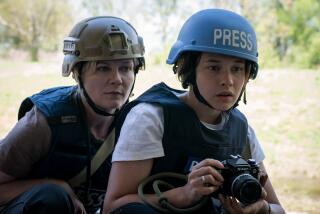‘I had to photograph this shocking event.’ What one journalist remembers 50 years after the Detroit riots
- Share via
In 1967, a young photographer working for a suburban Michigan newspaper lived just blocks from the flash point of what would become one of the most destructive riots in U.S. history. James Hubbard was one of the first journalists on the scene, and for five days he chronicled violence that left 43 people dead and more than 1,400 buildings burned.
The trouble started July 23 after a police raid on a “blind pig” — an after-hours club at 12th and Clairmount streets. Detroit was one of several U.S. cities hit by riots that summer as African American communities, frustrated by inequality and harsh treatment by police, erupted in violence.
With the 50th anniversary of the riots approaching, Hubbard, now 74 and living in Venice, wrote his recollections of that day. It was a Sunday, about 10:30 a.m., when he drove up 12th Street and saw billowing smoke shrouding the street a few blocks ahead:
Slowing my car, I noticed a commotion inside a liquor store. I hit the brake. I watched when about 100 people inside the store began running out the storefront, over shattered glass on the sidewalk from the store’s broken plate glass window, and running toward me, carrying liquor bottles. ...
The only other humans I saw were looting or setting fires. Fearing for my life, I pressed the accelerator to the floor and sped along 12th Street through thick, black smoke, looting and fires.
At 12th and Clairmount, Hubbard saw more than 100 police officers standing in a park watching people loot stores across the street. He later learned they had been commanded to “stand back” until Michigan’s National Guard arrived. Hubbard rushed home to tell his pregnant wife, Brijinder, what was happening:
I explained to Brijinder what I had witnessed and pulled the .22 caliber loaded pistol my brother had given me from my dresser drawer and handed it to her. I took pause realizing this is my wife, carrying our child, having recently immigrated to the U.S. from her home in India. But I had to photograph this shocking event.
I explained that I had to go back to photograph the rioting and that if anyone came through the door to pull the trigger. When she asked when I would be back I said, “No idea.”
Hubbard recalls that the battle-hardened members of the 82nd and 101st airborne divisions, having recently returned from Vietnam, were deployed in Detroit to quell the unrest:
With the paratroopers arrival, heavy equipment also came, including armored personnel carriers and tanks. They later rolled along Detroit’s streets and created a noise never heard in Detroit — metal, not rubber, half tracks meeting concrete, carrying tons of the monster war machines, preparing to fire on buildings from where snipers fired at their enemy. The tanks were probably assembled in Detroit factories for World War II.
Hubbard joined soldiers on patrol in an open Jeep:
Our mission was to draw sniper fire, which had been dramatically increasing by the second day of rioting. We took fire early, jumped from the Jeep and laid down on the hard road behind and under the Jeeps.
A soldier said “take this” and handed me an extra rifle from the Jeep repeating, “Take this. You may need it.” I said, “Where’s the lock?” to unlock the trigger for firing and he showed me. More shots rang out and the soldiers fired a barrage toward a building. Within about three minutes, reinforcements arrived, followed by a tank. They opened fired on the building, but the snipers were never found.
When Hubbard finally got some rest, he reflected on what he had seen:
It was my first night’s sleep in three days. It was a long time before I drifted off, and I remember being conflicted over the events I had witnessed. Was this the cries of the poor, dispossessed? Or, conversely, violent opportunists sensing a moment when they could steal, set fires and attack the white power establishment? Racial polarities were real in the Motor City. Would justice come for all God’s children in Detroit from death and destruction?
But along with the horror, one moment stands out, when he photographed 82nd Airborne soldiers guarding a store — and allowing neighborhood kids to hold one of their rifles:
I would not soon forget the tender moment between these children and occupying forces. … The kids loved holding the rifle, a soldier’s tool of war. The children beamed with wide smiles on their faces.
ALSO
O.J. Simpson is granted parole after serving 9 years for Vegas robbery
Military veterans are ready to battle Trump to keep marijuana legal
‘I’m done’: Fed up with California, some conservatives look to Texas
More to Read
Sign up for Essential California
The most important California stories and recommendations in your inbox every morning.
You may occasionally receive promotional content from the Los Angeles Times.










